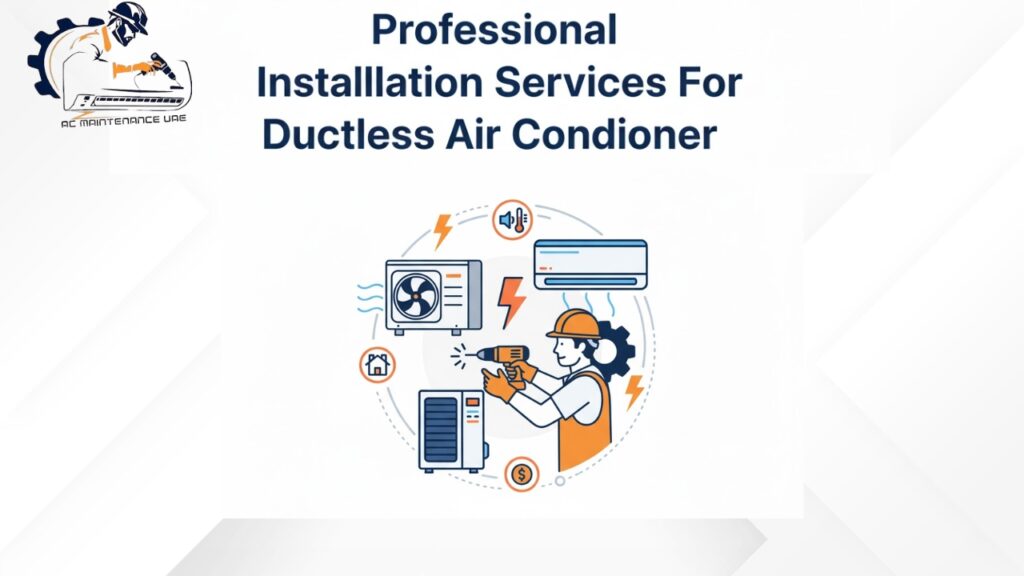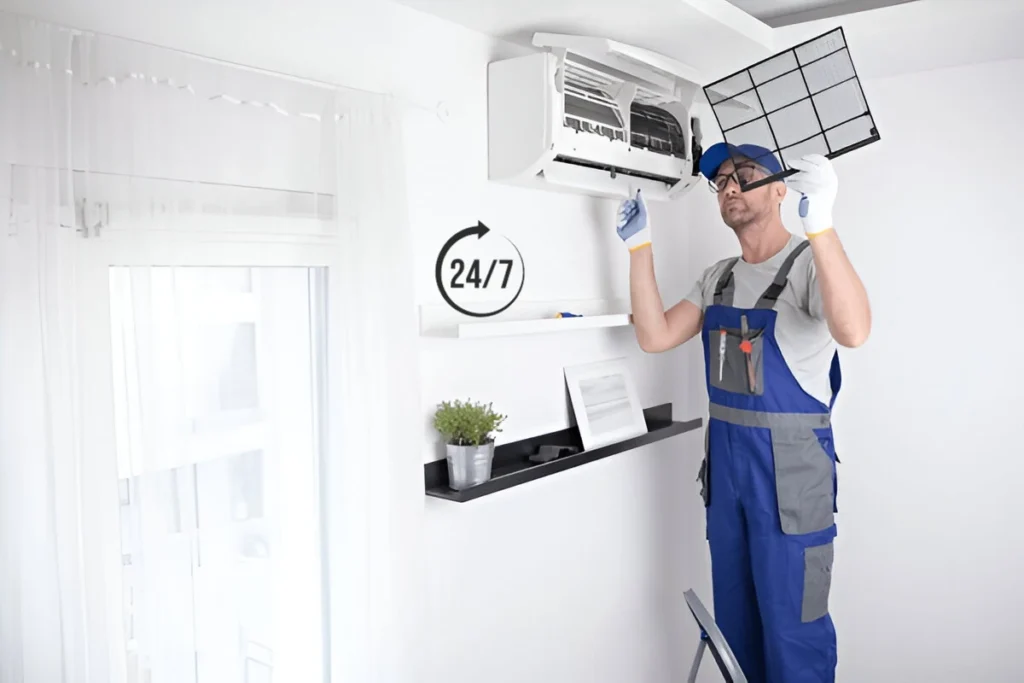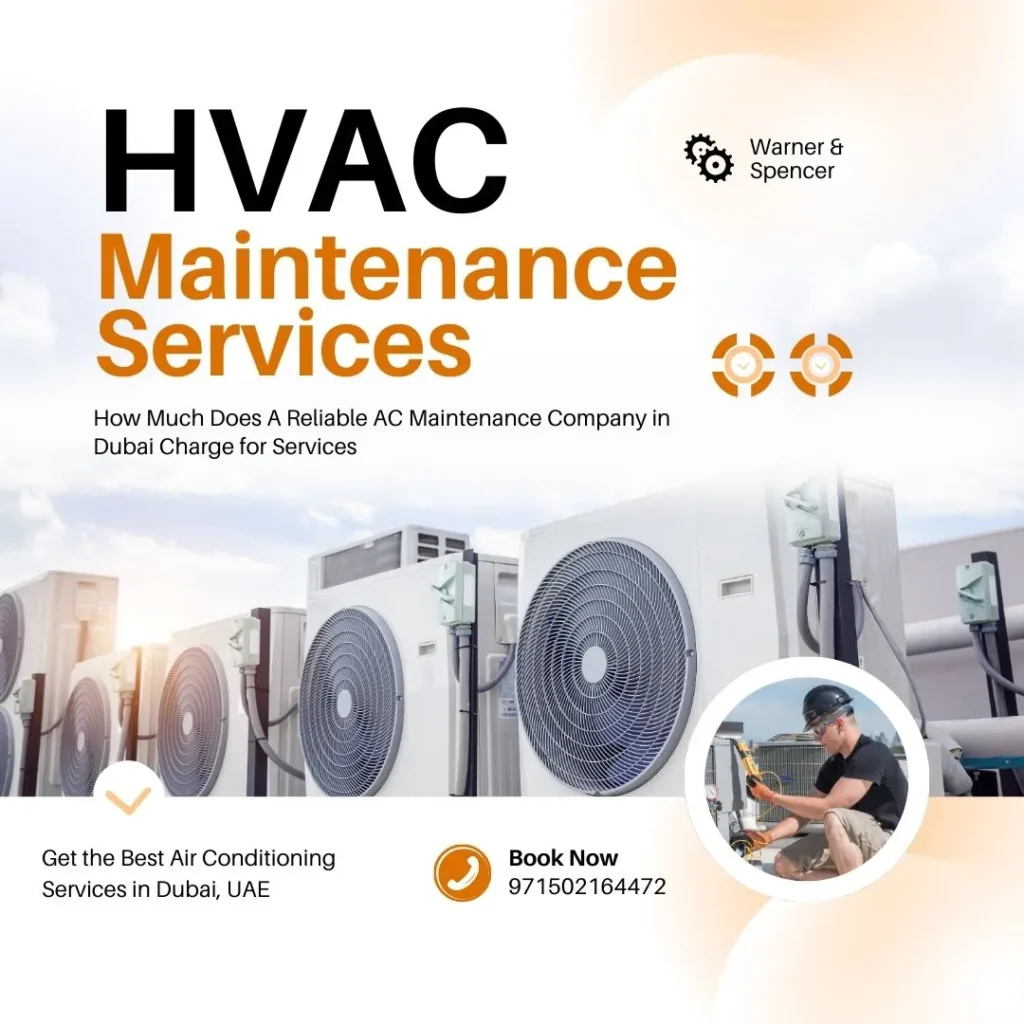Are you sick of having hot spots in your home that your central air can’t reach? Many homeowners deal with uneven cooling, high energy bills, and the trouble of putting in big ductwork. This guide will show you how to get complete control over your indoor climate, save money on energy bills, and make each room more comfortable with a ductless air conditioner.
Knowing your options makes all the difference, whether you’re adding a new room, fixing up an old one, or just want to keep your cooling costs down. Ductless AC systems are a modern solution that fits your way of life without the hassle of having to do major renovations like with traditional central air. The right installation partner makes sure that your investment works perfectly from the start.
Introduction to Ductless Air Conditioners
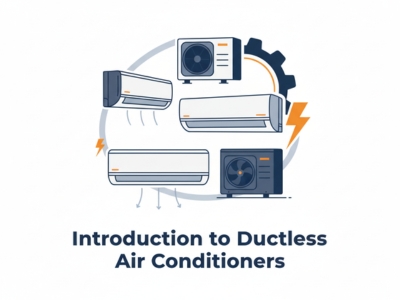
What Is a Ductless Air Conditioner and How It Works
A ductless air conditioner has an outdoor compressor unit that is connected to one or more indoor air handlers by refrigerant lines. The system cools certain rooms without needing a lot of ductwork. Refrigerant moves between units, taking in heat from inside and letting it out outside. Every indoor unit has its own thermostat and works on its own.
These systems are great for older homes, room additions, or places where traditional ducted systems won’t work because they are small. To install, you just need to make a small hole in the wall for the connecting lines.
Why Homeowners Are Switching to Ductless Cooling Systems
Leaky ducts in traditional central air systems let 20–30% of the cooled air escape. Ductless AC systems get rid of this waste completely. People who own homes like these units because they can set different temperatures in each room based on how they use them.
Efficiency is now more important than ever because energy prices are going up. These systems use inverter technology, which changes the speed of the compressor instead of turning it on and off. This means that these air conditioners use 30% to 40% less energy than regular ones.
Individual room control means you don’t have to pay to cool down empty spaces. We say that most of our clients see big drops in their utility bills during the first cooling season.
Types and Benefits of Ductless AC Systems
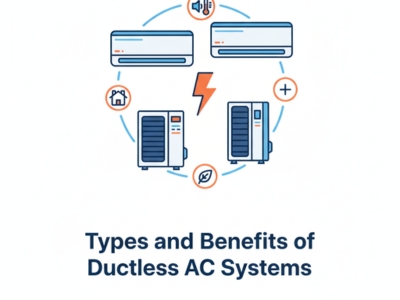
Ductless Mini Split Air Conditioner Overview
The ductless mini split air conditioner is the most common type of air conditioner for homes. A single outdoor unit can support up to eight indoor units, so it can be used in homes of any size. Most people choose wall-mounted units, but there are also ceiling cassettes and floor-mounted options for certain situations.
You can make different climate zones in your home with multi-zone systems. Parents can keep the bedrooms cool at night and the other rooms warm during the day when they aren’t being used.
Key Advantages of Ductless AC Systems
- Energy efficiency: Inverter technology adjusts cooling output precisely to match demand, preventing the energy spikes associated with traditional systems constantly cycling on and off.
- Installation flexibility: No ductwork means installation takes one to two days instead of weeks. Minimal wall penetration preserves your home’s structure and aesthetic appeal.
- Improved air quality: Built-in multi-stage filtration reduces dust, allergens, and odors. Without ducts collecting debris, you’re breathing cleaner air from day one.
- Quiet operation: Indoor units operate at whisper-quiet levels around 25 decibels quieter than a library. You’ll forget they’re running.
Ideal Spaces for Installing Ductless Units
Home additions and converted garages benefit most from ductless installation. Extending existing ductwork to these spaces costs thousands and often underperforms. Older homes built before central air became standard avoid major renovation expenses.
Sunrooms and bonus rooms above garages typically suffer from poor climate control. A dedicated unit solves temperature extremes instantly. Master bedroom suites gain personalized comfort without affecting other household members’ preferences.
Professional Ductless Air Conditioner Installation
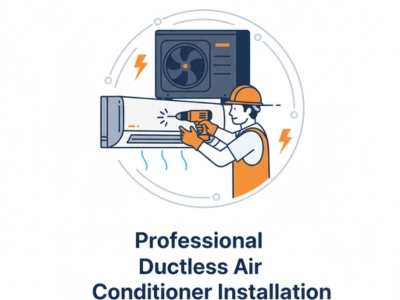
What to Expect During Installation
A site assessment is the first step in professional ductless air conditioner installation. Technicians check the electrical capacity, figure out the best place for the unit, and measure the paths of the refrigerant lines. This planning step makes sure the system is the right size and stops problems with performance in the future.
On installation day, the indoor unit is put in place, the outdoor compressor is put on a stable pad, and refrigerant lines are run through a three-inch hole in the wall. According to local codes, electrical connections need to have the right amount of circuit capacity and safety disconnects.
The last step is to vacuum test the refrigerant lines to get rid of air and moisture, charge the system, and check that everything works. Before finishing the job, our technicians will show you how to use and care for the equipment.
Importance of Hiring Certified Technicians
- Refrigerant handling requires EPA certification for legal and safety reasons.
- Improperly charged systems perform poorly and fail prematurely.
- Warranty protection depends on professional installation.
- Manufacturers void coverage if unqualified individuals attempt the work.
- Your investment deserves the protection that comes with certified service.
- Electrical work carries serious safety risks.
- Certified technicians have specialized tools like vacuum pumps, manifold gauges, and leak detectors that ensure proper installation.
Common Mistakes to Avoid During Installation
Putting too many units in a space wastes money and causes short-cycling, which lowers efficiency and lifespan. When figuring out the right load, you need to take into account the size of the room, the quality of the insulation, the amount of sunlight the windows get, and the weather in the area. For accuracy, technicians use Manual J calculations that are standard in the industry.
Putting indoor units in the wrong place makes the air flow in an uncomfortable way and makes them less effective. Units need enough space for air to flow around them, and they should move air across the room instead of directly at people.
Not enough insulation on the refrigerant line can cause condensation problems and waste energy. Lines need to be properly supported so that there are no kinks or sharp bends that stop flow. These details set professional installations apart from those done by amateurs.
Understanding Ductless Air Conditioner Installation Cost
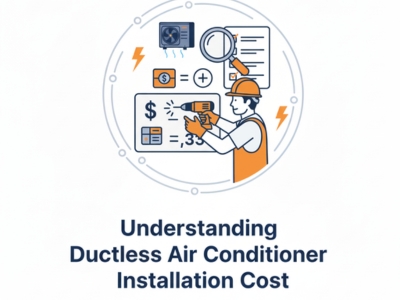
Factors That Influence Installation Costs
Ductless air conditioner installation cost varies based on several factors. System capacity measured in BTUs affects the price larger rooms need more powerful units. Single-zone systems start around $2,000-$4,000 while multi-zone configurations range from $4,000-$14,000 depending on the number of indoor units.
Installation complexity impacts labor costs. First-floor installations with outdoor units placed nearby cost less than second-story work requiring longer refrigerant line runs. Wall construction material affects installation time; concrete requires different tools than wood framing.
Brand selection influences upfront investment. Premium manufacturers offer advanced features like Wi-Fi control and superior efficiency ratings.
Comparing DIY vs. Professional Installation
How to install ductless AC guides might tempt handy homeowners, but this isn’t a DIY project. Refrigerant handling requires certification, and mistakes cause expensive system damage. Improper vacuum procedures introduce moisture that corrodes components and reduces lifespan dramatically.
Electrical work needs permit inspection in most jurisdictions. DIY installations that skip permits create liability issues during home sales and insurance claims. Professional installation includes proper permitting and inspection coordination.
The time investment for DIY attempts easily reaches 20-40 hours for first-timers. Professional crews complete installations in one day with warranty protection and guaranteed performance.
Long-Term Value and Energy Savings
Energy savings offset installation costs within 3-7 years for most homeowners. Monthly utility bills drop $50-$150 depending on usage patterns and local electricity rates. Over a 15-year lifespan, savings can reach $10,000-$25,000.
Reduced maintenance needs lower long-term ownership costs. Simple filter cleaning every few months maintains performance. No ductwork means no professional duct cleaning expenses every few years.
Home value increases with modern climate control systems. Buyers appreciate energy-efficient features and room-by-room comfort control. Properties with ductless AC system installations sell faster in competitive markets.
How to Install Ductless AC — A Step-by-Step Overview
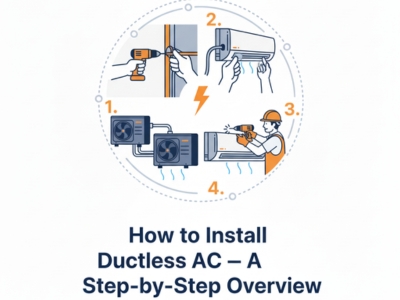
- Preparing the Installation Site
Choosing indoor unit locations that will allow for even air distribution is the first step in site preparation. Units should be mounted on interior walls 7 to 8 feet high, away from direct sunlight and heat sources. Putting furniture in the wrong place shouldn’t block air flow.
When putting the outdoor unit in place, the ground must be level or there must be a wall-mounted bracket that is far enough away from plants and buildings. For proper airflow and maintenance access, units need 12 to 24 inches of space on all sides.
Verification of electrical service makes sure that the new load can be handled. Most systems need separate 20 to 30 amp circuits, depending on how much power they can handle. Older homes may need to have their panels updated.
- Mounting the Indoor and Outdoor Units
To install an indoor unit, you need to attach a bracket securely to the wall studs. Once the electrical and refrigerant connections are made, the unit snaps onto this bracket. A hole three inches wide drilled through the wall at a slight downward angle lets condensate drain and stops water from backing up.
Outdoor compressor units are either mounted to the outside walls with vibration-dampening brackets or sit on concrete pads. Leveling the compressor correctly stops operational noise and makes sure that the oil flows properly.
The refrigerant line sets go through the hole in the wall and connect the indoor and outdoor units. Lines need to be completely insulated so that condensation doesn’t happen and energy isn’t wasted. To keep leaks from happening, connection points need the right amount of torque.
- Testing and Final Setup
Before charging the system, vacuum testing gets rid of all the air and moisture in the refrigerant lines. This process takes 30 to 60 minutes and stops contaminants from causing long-term damage. Electronic vacuum gauges are used by technicians to make sure that the evacuation is done correctly.
Adding the exact amount of refrigerant that the manufacturer says is needed is part of system charging. Too much or too little makes things less efficient and can break parts. Manifold gauges for professional measure pressures to make sure the charge levels are right.
The last test checks that all of the operating modes work as they should. Technicians check the differences in temperature, the flow of air, and how the thermostat responds. The installation is finished when you program the remote controls and explain how to take care of them.
Finding Reliable Ductless Air Conditioner Installation Near Me
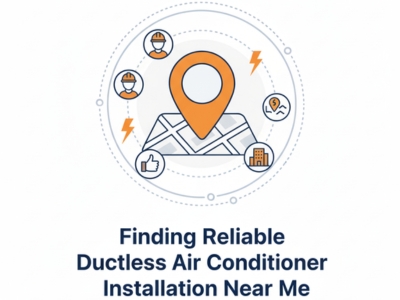
What to Look for in a Local Installation Company
- When searching for ductless air conditioner installation near me:
- Start with companies that specialize in these systems rather than general HVAC contractors.
- Manufacturer certifications indicate training on specific brands and access to warranty support.
- Written estimates should detail equipment specifications, labor costs, and expected completion timeline.
- Vague quotes often hide surprise charges that appear after work begins.
Checking Reviews, Licenses, and Experience
- Online reviews show trends in how well problems are solved, how good the service is, and how well the work is done.
- Don’t just look at star ratings; read full reviews.
- Companies that have hundreds of positive reviews show that they always do a good job.
- Different areas have different licensing requirements, but they usually include contractor licenses and EPA refrigerant handling certification.
- Ask for license numbers and check with local regulatory agencies to make sure they are still valid.
- Years in business show that a company is stable and has experience.
- Businesses that have been around for more than ten years have dealt with changes in the market and built reputations that are worth protecting.
- Find out how much experience the technician has with ductless systems.
Why Local Services Offer Better Maintenance Support
- When service needs come up, local businesses act quickly.
- On hot summer days, emergency repairs can’t wait for contractors from other towns to set up service calls.
- Proximity means that service is available the same day or the next day.
- Seasonal maintenance makes sure that systems work at their best.
- Yearly inspections find small problems before they turn into costly repairs.
- Local providers make it easy to make appointments by sending reminders and letting you choose when to meet.
- Making friends with local providers will pay off over the 15 to 20 years that your system will be in use.
- Technicians who are familiar with your specific installation do a better job during maintenance visits and know how your property is different from others.
Frequently Asked Questions
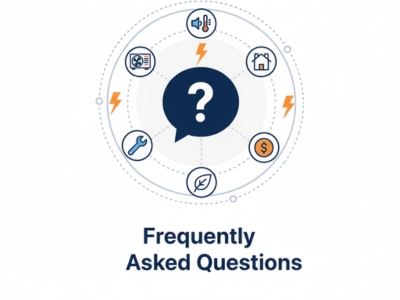
How much does ductless air conditioner installation cost on average?
Installation costs typically range from $2,000-$4,000 for single-zone systems and $4,000-$14,000 for multi-zone configurations.
Can I install a ductless mini split air conditioner myself?
While technically possible, DIY installation isn’t recommended. Refrigerant handling requires EPA certification, and improper installation voids warranties.
How long does professional installation take?
Most single-zone installations complete in 4-6 hours. Multi-zone systems requiring multiple indoor units may take 1-2 days depending on complexity and home layout.
What size ductless AC system do I need for my space?
Room size, insulation quality, ceiling height, and sun exposure determine proper sizing.
Are ductless systems suitable for whole-home cooling?
Yes, multi-zone systems effectively cool entire homes. Each indoor unit operates independently, providing personalized comfort in different rooms while maintaining energy efficiency.
How often do ductless systems need maintenance?
Clean indoor unit filters monthly during heavy use periods. Schedule professional maintenance annually to check refrigerant levels, clean coils, and verify proper operation.
Do ductless systems work in cold climates?
Modern cold-climate ductless mini split air conditioner units provide reliable heating down to -15°F or lower.
Make the Smart Choice for Your Home Comfort
A ductless air conditioner changes the way you feel comfortable in your home and saves you a lot of money on energy costs. Certified technicians will install your system professionally, which will make sure it works well for decades. These systems are the best choice for modern homes because they let you control the temperature in each room, run quietly, and improve the air quality.
Now that you know how professional installation will make the most of your money, are you ready to enjoy comfort in every room? At AC Maintenance UAE, our certified technicians offer professional installation services that are customized to meet the needs of your home.
Set up your free consultation today and start saving money on your energy bills while staying comfortable all year long.
AC Maintenance UAE Team
Welcome to AC Maintenance UAE, your reliable partner for complete air conditioning repair and maintenance services in Dubai, Sharjah, and Abu Dhabi. We are strongly dedicated to excellence and deliver efficient and reliable services to keep your cooling systems performing at their best.

